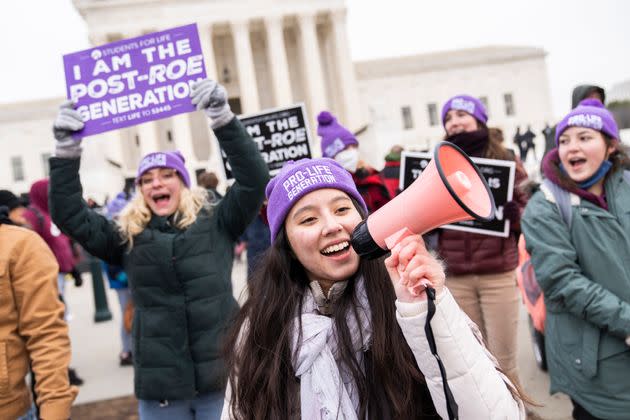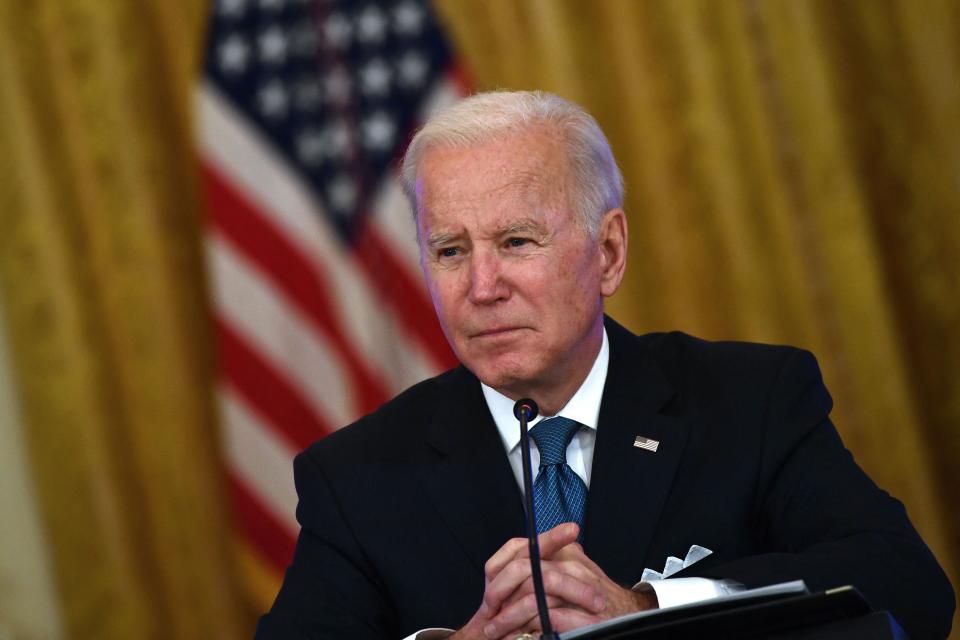Supreme Court Conservatives Plot A Liberal Apocalypse In 2022
The Supreme Court’s six-member conservative supermajority will flex its muscle in a series of high-profile cases in 2022 that will agonize liberals while fulfilling some of the wildest dreams that have eluded the conservative movement since it came to power with Ronald Reagan’s 1980 presidential election.
The changes anticipated to abortion, affirmative action, gun rights, school prayer, rights of criminal suspects and the federal administrative state could transform U.S. law and upend American politics. This moment is the fruition of a decadeslong strategy by conservatives to seat justices willing to overturn elements of the New Deal order and rights revolution of the 1960s and ’70s that presidents and Congresses could not through executive action and legislation.
From the 1930s to the 1970s, presidential administrations and the judicial branch, in particular, expanded rights granted under the Constitution beyond the protection of property and the incorporation of business to protect individual citizens, including women, racial minorities, criminal suspects and workers, for the first time.
Reagan, and the conservative movement that brought him to power, intended to end this liberal project and reverse its gains. His administration’s efforts to repudiate the previous 50 years of American governance started with a push for legislation and constitutional amendments. While Reagan was able to end the New Deal era, conservatives could not roll back the advances of civil and voting rights, the rights of women to bodily autonomy or the removal of Christian prayer from schools. They also could not rid themselves of the influence of the federal administrative state, which grew deeper every decade since its vast expansion during the New Deal.
And so they turned to the courts.
The Federalist Society formed in 1982 with the help of close Reagan aides like Ed Meese, with the aim of training and promoting conservative lawyers. Its ranks would soon populate the federal bench, as Reagan became the first president since Franklin Roosevelt to appoint more than half of the federal judiciary.

It took 40 years, but after a few bumps ― including the apostasy of Justice David Souter, the failed nominations of Robert Bork and Douglas Ginsburg and the moderation (on some issues) of Sandra Day O’Connor and Anthony Kennedy ― conservatives secured a rock-solid majority on the Supreme Court after Donald Trump named three justices handpicked for him by Federalist Society leaders.
Now, in its second full year on the bench, the court’s supermajority looks to hand its fellow conservatives victories that will leave liberals reeling and worried about what more is to come.
Roe v. Wade
The highest-profile case before the court this year is Dobbs v. Jackson Women’s Health Organization, a challenge to the precedent legalizing abortion in the 1973 Roe v. Wade decision. The case involves a 2018 Mississippi law banning abortion services after 15 weeks of gestation. Lower courts struck down that law as a violation of both Roe v. Wade and Casey v. Planned Parenthood, the 1992 case that both affirmed and limited abortion rights. The state of Mississippi appealed to the Supreme Court.
On appeal, the state’s lawyers went beyond arguing for the constitutionality of their statute limiting abortion services, arguing instead for the wholesale reversal of the precedents set by both Roe and Casey. Abortion rights precedents “haunt our country,” Missisippi’s solicitor general argued before the Supreme Court on Dec. 1, and “choked off compromise,” among supporters and opponents of abortion rights.
Justices Brett Kavanaugh, Clarence Thomas and Samuel Alito openly agreed with this premise. Kavanaugh praised past landmark decisions that overturned precedent, like Brown v. Board of Education, and argued that the court should remain “scrupulously neutral on the question of abortion — neither pro-choice nor pro-life.” Alito compared Roe with the court’s “egregiously wrong” Plessy v. Ferguson precedent upholding “separate but equal” racial discrimination.
There is significant expectation that the court has enough votes to overturn Roe v. Wade after it refused to halt the new Texas anti-abortion law, which is specifically designed to circumvent Roe’s protections by routing enforcement through a system of bounty rewards to members of the public.
Affirmative action
Affirmative action college admissions programs are also almost certain to fall this year after the court announced it would take up two cases brought against Harvard University and the University of North Carolina. There is little doubt that conservatives have enough votes on the court to end race-based admissions criteria for colleges and universities.

The last time the court considered the issue was in 2016, when then-Justice Anthony Kennedy sided with the court’s liberals to uphold the limited affirmative action program at the University of Texas. Since then, the court has swung further right, with Kavanaugh replacing Kennedy and Amy Coney Barrett filling the seat of the late Justice Ruth Bader Ginsburg.
Thomas, the court’s lone Black and most conservative justice, has long been the most vocal opponent of affirmative action programs. He was appointed by Reagan to head the Equal Employment Opportunity Commission in part due to his antipathy to the commission’s mission, including opposition to affirmative action programs. On the court, Thomas has repeatedly stated his preference to end all university affirmative action programs.
Just like abortion, ending university affirmative action programs would achieve a long frustrated policy goal of conservatives. Reagan campaigned on ending affirmative action programs, his Justice Department joined the court challenges to them and appointees like Thomas worked to disable them from the inside. All prior legal challenges failed to wipe out affirmative action programs entirely, but that is almost certain to change now.
The administrative state
Where the court’s expected rulings on abortion and affirmative action look to roll back key elements of the mid-20th century rights revolution, cases challenging executive branch regulations regarding climate change, West Virginia v. Environmental Protection Agency, and pharmaceutical drug prices, American Hospital Association v. Becerra, aim further back in time to dismantle the New Deal state.
One foundation of FDR’s New Deal was the expansion of the executive branch to provide for democratic regulation of the economy in order to, as Roosevelt said in his second inaugural address, “bring private autocratic powers into their proper subordination to the public’s government.” What makes the administrative state effective is Congress’ delegation of authority to executive agencies to write new rules and regulations as the need arises and circumstances change.
But conservatives have increasingly sought to limit, or eliminate, the ease of agency delegation in recent years.
The case of American Hospital Association v. Becerra presents an opportunity for the court’s conservatives to further limit, or outright overturn, the 1984 precedent of Chevron v. Natural Resources Defense Council that provides for the general deference of courts to executive agency rulemaking. The so-called Chevron deference was created by the court as it ruled in favor of changes made by EPA Administrator Anne Gorsuch loosening the agency’s pollution emission regulations.
While conservatives initially backed the Chevron deference, they have moved hard against it in recent years. In a 2013 dissent joined by Alito and Kennedy, Roberts declared that his “disagreement” with the majority opinion upholding the Chevron deference “is fundamental.” Justice Neil Gorsuch, the son of the former EPA administrator, is perhaps the court’s most fervent opponent of the Chevron deference and, if the court is to overturn the ruling creating it, is likely to be opinion’s author.
The court may go beyond overturning Chevron when it hears West Virginia v. EPA, a preemptive challenge to the Biden administration reviving regulations limiting carbon emissions first introduced under President Barack Obama as the Clean Power Plan and since stalled by the courts. In order to halt any new limits on carbon emissions meant to combat climate change, the court could resurrect the “nondelegation doctrine” not used since the days of the early New Deal.

The nondelegation doctrine is a theory that Congress cannot delegate authority to an executive agency to set rules and regulations without specific direction. The doctrine has only been raised twice by the court to strike down executive agency action, both times in 1935, when the court struck down elements of FDR’s first New Deal.
In a string of recent opinions, Roberts, Kavanaugh and Gorsuch have all shown interest in the principles of the nondelegation doctrine by invoking something called the “major questions doctrine,” an outgrowth of nondelegation. According to the major questions doctrine, any executive branch action of significant national importance that could outstrip its authority granted in legislation must be expressly authorized by Congress. This doctrine has begun to replace the Chevron deference for the court’s conservatives as they move to limit the ability of the federal administrative state from regulating economic activity.
This was seen most recently in the court’s opinion striking down the Biden administration’s COVID-19 vaccine-or-test mandate for major employers. The court’s conservatives ruled that the Occupational Safety and Health Administration could not order employers to institute a vaccine-or-test mandate for workers during the pandemic because Congress did not specifically authorize that action in legislation creating or further empowering the agency.
“The major questions doctrine serves a similar function” as the nondelegation doctrine, Gorsuch wrote in a concurring opinion on the vaccine-or-test mandate, “by guarding against unintentional, oblique, or otherwise unlikely delegations of the legislative power.”
The continued broad application of the major questions doctrine could serve the same role as the nondelegation doctrine to strike down wide swaths of executive branch actions and regulations. And the decision in West Virginia v. EPA will likely set the tone for further challenges aimed at hobbling the administrative state.
Guns, school prayer, Miranda rights
The 2022 conservative offensive does not end with the rollback of the rights revolution and the New Deal state.
In New York State Rifle & Pistol Association Inc. v. Bruen, the court is expected to strike down New York state’s limits on providing concealed carry permits for firearms. The state’s law requires a person to show “proper cause” for the need to defend themselves to obtain a permit.
The court has also taken up two challenges to Warren Court-era precedents, including a challenge to the prohibition on religious prayer in public schools and another to the Miranda rights of criminal suspects.
Unlike the abortion, affirmative action and administrative state cases, these are not likely to present blockbuster changes to court precedent, but rather a continued incremental chipping away at the edges. These incremental changes may also chart the course for the future of the court’s six-vote conservative supermajority as it continues reshaping the country uncontested for the foreseeable future.
Liberals hoped for a political realignment away from the conservative era inaugurated by Reagan’s 1980 election with the defeat of Trump in 2020. Instead, they will have to reckon with a conservative court that looks to finish the job that Reagan began – even as the political coalition Reagan built can no longer win a national political majority.
Minority rule by conservatives through the courts will end up defining the direction of politics for the decades to come – unless liberals finally choose to take political action to counter the court’s power.
This article originally appeared on HuffPost and has been updated.

 Yahoo Finance
Yahoo Finance 




